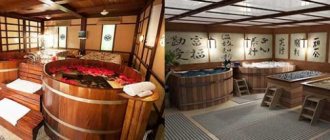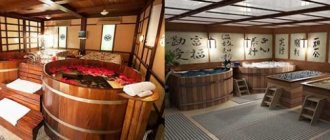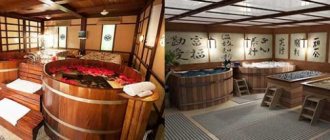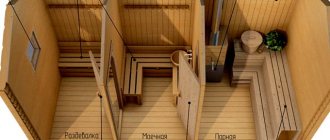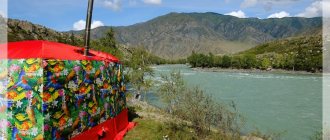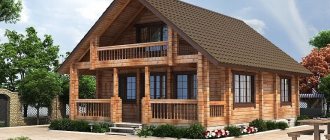Stories about Japanese baths always feature a barrel of furako. She is popular all over the world. The oforo bathhouse is less known. The full range of Japanese bath procedures does not involve entertainment. In ofuro, a person moves from the font into boxes with sawdust and smooth stones. This is a complex healing and relaxing action.
Stories about Japanese baths always feature a barrel of furako. She is popular all over the world. The oforo bathhouse is less known. The full range of Japanese bath procedures does not involve entertainment. In ofuro, a person moves from the font into boxes with sawdust and smooth stones. This is a complex healing and relaxing action.
Miraculous healing
The ofuro bathhouse combines three wellness procedures. The Japanese, when choosing a bathhouse to improve their health, always inquire whether there is ofuro in the complex. One barrel is offered by charlatans. They won't go to such an establishment.
Warming up in the four elements cures a number of diseases:
- Rheumatism
- Arthritis and arthrosis
- Colds
- Diseases of the genitourinary system
The Japanese furako bath relieves muscle tension in hot water. This is a separate, independent type of bathhouse. Additional heating strengthens the immune system and rejuvenates the skin. Helps to lose extra pounds.
The Japanese ofuro bath takes time. After immersion in each element, rest and ablution are necessary. Upon completion of the procedures, you need to recover in the relaxation room. Many people go to bed before drinking tea. Order a relaxing body massage. It is not surprising that in Japan foreigners are rarely invited to ofuro.
Certain healing elements of the Japanese bath are known as types of therapy.
Phytobarrel
In the sanatoriums of Altai and Khakassia they will definitely tell you that in the 70s of the last century, the phyto-barrel was invented in these places. Veterinary paramedic V. Podtrebkov cured his daughter by laying her on fir branches in a bathhouse. Later he came up with a barrel into which steam flowed. The procedure barrel was filled with a collection of medicinal herbs.
In the 90s, P. Losevskaya refined the method of treatment by heating in herbal mixtures. Guests of Altai are recommended to visit the “Altai Phytosauna”. The cosmetic and health benefits are impressive.
Stonetherapy
Another type of alternative medicine. It came from China. This is a flat pebble massage. Depending on the patient’s condition, heated or cold stones are used. The method is based on the esoteric teaching of the elements. But it helps with sore joints and a number of other diseases.
Elements of herbal medicine and stone therapy are two wooden ofuro boxes in a Japanese bath. The effectiveness of each procedure is enhanced by preheating in the barrel. In fact, furaco baths are hyperthermic baths. They speed up metabolic processes, which promotes health.
Stones – point massage
After you thoroughly steam your body in a furaco, you will be asked to lie down in a barrel, the bottom of which is covered with pebbles heated to 40º C. The specialist will place individual pebbles on biologically active points of your body. Stone therapy will relieve you of heaviness in your legs, have a beneficial effect on the nervous system and even help you lose weight, because hot stones cause blood flow to problem areas and thereby speed up metabolism. But above all, the procedure is most effective for relieving stress, depression and general relaxation of the body. “Communication” with pebbles lasts about 20 minutes on average.
Ofuro box design
At first glance, it is a simple wooden box. But it is designed for regular heating to 60 degrees. Even the pickling barrels dry out during the summer months. They must be soaked before use. Wood “walks” when temperature and humidity fluctuate.
Metal and plastic fasteners are not allowed in the ofuro box. Requires the skill of Japanese carpenters. So that the wooden bathtub does not dry out or crack on the first day of use.
Japanese woodworking
Japanese carpenters did not use glue or nails. To connect the wooden parts, grooves and tenons were precisely adjusted. The cross-section of the connection has a complex profile. At the same time, they did not use sandpaper or drills. Precision fitting was achieved with a limited set of tools.
The art of creating strong wooden joints is called tsugite. Today, such precision of parts is achieved on CNC machines. Manufacturers of equipment for furaco baths use thermal wood. It is obtained by drying lumber at high temperatures. Thermowood does not dry out or swell from moisture.
Furaco side material
No matter what kind of wood the sides of this pool (or an individual barrel) are made from, the cells of the tree for a very long time, for years, release all sorts of aromatic and tanning substances into the water, which affect the general condition of a person with their microdoses (which is the meaning of a wooden barrel). The most expensive furaco baths of this kind are, naturally, created from valuable and rare types of wood: boxwood, myrtle, sakura, laurel. Sometimes the source material, tree trunks, is so miniature that a set of pool sides is made up of several thousand boards - and this is with a tub diameter of only 5-6 meters. Great skill is required so that the set does not crumble inward due to the pressure of the rivets, either swelling from water or drying out without it, wood. This is also why the sides of the tub are constantly kept wet - even when the volume of the pool is not used for its intended purpose.
- Gallery
Choose a model based on the experience of our clients and consultant managers! We wish you and your loved ones health!
Wood selection
Plywood and chipboard cannot be used for the box. There must be a high-quality array. Not just any tree will do. The Japanese ofuro bathtub is never made of pine. This is a coniferous tree; when heated, the wood “cries” with resin.
Coniferous species used for Japanese baths are larch and cedar. Larch is a tree that is resistant to dampness and temperature changes. Cedar is considered a healing tree. When heated, it smells pleasant and releases phytoncides. Dense and durable oak wood is suitable for the box.
In Russia, manufacturers of Japanese baths used linden. Its wood is soft and, when heated, emits a delicate aroma. Furaco baths made from linden are ordered for herbal medicine.
Box parameters
| Width | 800 – 1000 mm |
| Length | 2000 mm |
| Height | 800 –1100 mm |
The wall thickness is 4.5-5 cm. The dies are placed vertically. A dovetail connection is used. At the head there is a semicircular elevation. Several steps are needed to enter the box.
Now electric heaters are installed to heat sawdust and stone. They are built into the bottom of the box. Once upon a time, the Japanese ofuro was heated by a wood stove. But there is no information about its device.
The amount of sawdust for a standard single ofuro box is 45-50 kg. To replace wet sawdust after one procedure, 2-3 kg are required.
Sawdust is made from types of wood:
You can take sawdust from birch, fruit trees, and cypress. The sawdust is prepared for use. They are impregnated with aromatic oils. Mix with dry herbs.
Important. Recipes for herbal infusions for the treatment of various diseases were developed by P. Losevskaya. These are dry mixtures of herbs for steaming in a phyto-barrel, teas, balms and oils for massage. All plants are collected in the Urals, Altai and Siberia. Herbalists recommend Japanese baths with these drugs.
Where else to take a steam bath?
Turkish hammam . A distinctive feature of the hammam is its special soft microclimate, which does not cause contraindications and does not dry out the skin at all: the steam room temperature is kept at 40-50 ° C, and the humidity reaches 100%. The bath procedure consists of several stages: it is a harsh but extremely effective massage (from the outside it seems that the human body is kneaded like dough), peeling, which is performed traditionally with mittens made from ponytail hair (kise). The final and perhaps most pleasant procedure is a relaxing soap massage. Foam from hand-made soap, soft washcloths and all kinds of essential and aromatic oils that soften the skin are used.
Finnish sauna . Finns love to steam no less than Russians. They say that in Suomi there is one sauna for every four local residents. By the way, it actually differs little from a Russian bathhouse - there are no less steam in it, and it is often heated, as is customary in our tradition, in the black way. Before plunging into hot clubs, do not eat or drink a lot of liquid - a sacred Finnish rule, and after warming up as much as possible, try diving into ice-cold water - not so much for show, but for your own health. But remember that you can steam no more than 2-3 times a week.
Japanese ofuro baths from start to finish
In addition to the furaco barrel and ofuro boxes, couches, benches, and stools for relaxation are placed in the bathhouse. Preparation of oak barrels and boxes begins in the morning. In Japan, girls serve customers. They help take baths and monitor the well-being of guests.
The Japanese sauna is not intended for bathing. Visitors wash in the showers before plunging into the communal furo barrels at the sento baths. Or in the font for company.
In many photos there is more than one barrel of hot water in the room. The water in the baths is of different temperatures. To begin with, it is recommended to warm it up in water at 35 degrees. After rest, descend into hot water at 40-45 degrees.
Again follows rest and preparation for immersion in the fragrant sawdust. Bathhouses Furako and Ofuro are advertised by girls in bikinis. In the photo in the booklets they are lying in boxes with sawdust in attractive poses. In a real bathhouse, you wear a special robe. Or they wrap themselves in a sheet. In this form they are placed in a box. Hot sawdust is poured over the body.
Lying in hot sawdust, a person sweats profusely. When he gets up, the layer of damp sawdust is removed. A fresh portion is added for the next visitor.
The next Japanese ofuro bath is filled with pebbles made from volcanic rocks. These minerals hold heat well and do not crack when heated, like limestone.
The hot stones are covered with a sheet. The visitor lies face down. Large white and black pebbles are placed on his back. It is believed that this restores the balance of elements in the body. Stones are used to lightly massage certain points on the spine. Next comes the washing of the body.
Furaco baths for health purposes are taken every three days. The Japanese find time to get rid of illnesses and stress.
Duration of procedures in the Ofuro bath
| Procedure | Heat | Time |
| Body washes and hot showers | ||
| Dive into the first plunge pool | Water 35 degrees | 10 – 15 minutes |
| Relaxing on the couch | Up to 30 minutes | |
| Immersion in the second font followed by rest | 45 degrees | 30-40 minutes |
| Ofuro with sawdust | Up to 50 degrees | 15 minutes |
| rest | 20-30 minutes | |
| Ofuro on the rocks | Up to 60 degrees | 20 minutes |
| Relax in a private room | Air 23-25 degrees | Before recovery |
Water temperature and how it is maintained
The water temperature is maintained at 42-45 degrees, that is, it feels 6-9⁰C higher than the temperature of the human body and such water is perceived as quite hot, but tolerable. It’s no longer possible to sit above chest level—you won’t be able to sit for long. And the requirement to sit in water so that its level is no higher than the middle of the chest is associated with the rhythm and strength of the heart when the body is heated: as soon as you dive 5 cm deeper, the heartbeat quickens, breathing becomes more difficult, and about some It’s already difficult to talk about the comfort and even the benefits of bath procedures.
The water is heated by a wood-burning or electric stove, which is structurally integral with the tub. The stove can be brick, stone or cast iron; in Japan there is an entire metallurgical production dedicated only to the production of special fireboxes for furako baths. Although, if the pool is of non-standard size or shape, craftsmen often prefer stone or brickwork, which is easier to adjust to the size of the tub.
DIY Japanese Ofuro baths
Some people mistakenly think that the Japanese ofuro bath is an elongated barrel. It’s easy to find information on the Internet about how a wooden barrel for an outdoor font and bath boxes is constructed. There are many instructions for building a separate pavilion. The Japanese ofuro bathhouse is always located in a spacious room.
Experts believe that setting up a home sauna with boxes of sawdust is impractical and expensive. Japan is an example. Public baths are popular there. At sento, everything is done by the staff. Preparing a barrel for procedures is a troublesome task. Guests come to everything ready. It is believed that self-care in ofuro prevents you from focusing on your physical and mental health.
Many spas in major cities offer a "Japanese bath". You can visit it together, or with a small company. Guests will be served by experienced massage therapists. If your health worsens due to unusual temperatures, a doctor will intervene.
Spas purchase sawdust from trusted suppliers. Wood must be from environmentally friendly places. The sawdust size is the smallest.
But increasingly, Japanese ofuro baths are being built on private property. Barrels, stoves and heaters, wooden boxes are purchased from reliable companies. Furaco baths made of high-quality wood are safe for health and do not create problems.
Mosaic, tea ceremony and sabi-wabi
The hallway in Ofuro is not too fancy. The only mandatory requirement that Japanese interior style places on it is built-in wardrobes. The Japanese bath does not like loosely hung clothes and open sections for storage.
By tradition, complex mosaic floors, stone, and expensive wood are allowed in this room. However, the most common and stylish design option is a continuous, almost without transitions, cladding of all surfaces with small mosaics. In this case, as a rule, two benches, a shower stall and a chair with a foot bath are installed in the shower room.
In the shower room, in addition to a warm water floor, it is optimal to install a water heating system for the walls, “stone” benches and chairs.
Continuous mosaic cladding is done after wooden (or brick-built) benches and an armchair are sheathed with polymer panels, for example, sheets of polymer cement. It bends perfectly and is very easy to install. The polystyrene in its composition provides the necessary waterproofing. Since such panels provide a good leveling base, tiles and mosaics are laid directly on them.
These same stone benches will serve as excellent massage tables. The room for the tea ceremony is also not easy. In the classic version, it is almost devoid of furniture. However, this is a distinctive feature of all Japanese interiors - people sleep, eat and sit on mats. For a Russian person, especially after a magnificent ofuro bath procedure, this option is hardly suitable.
If you are not a fan of the Japanese tea ceremony, then there is no point in following exact instructions for building a tea room. It is quite possible to limit ourselves to stylization. To do this, it will be enough to follow simple rules. The room is zoned due to movable screens, lighting, and different textured floors. Natural materials have minimal processing, but are complemented by unique handmade decorations. Things are stored in built-in wardrobes or traditional Japanese chests, maximum free space, minimum furniture. The restrained color palette is limited to natural tones. Soft and dim lighting imitates daylight passing through closed curtains.
Way of the Samurai
The bath ceremony in Japan is a whole philosophy. This explains the special attitude towards ofuro. It is in the traditions of this people to find a philosophical and epic beginning in every pleasant procedure, be it tea drinking or ablution. Bath, in accordance with Japanese traditions, is a combination of the four elements that make a person invincible. Ofuro combines fire, water, earth (wood) and air. A person who has gathered these elements into a single whole becomes an absolute warrior. With these thoughts in mind, you should visit a Japanese bathhouse, even if it is built on your personal plot.
“Construction Rules”, No. 26/1, December 2011
The copyright holder of all materials on the site is Construction Rules LLC. Full or partial reprinting of materials in any sources is prohibited.
